The Fashion Metaverse is Here. Are You Ready?

- Oops!Something went wrong.Please try again later.
On the ski lift everyone is wearing Ralph Lauren: knitted Polo Sport beanies and colorblock fleece jackets. At the rink pillowy snow falls on primary-hued RL backpacks and sporty Polo totes as skaters whip and pirouette across the ice in big pony logos, hot chocolate from Ralph’s Coffee in hand. This is not the real world. It is the universe conjured inside the online gaming platform Roblox. The metaverse, if you will.
Today’s ubiquitous buzzword was coined by the writer Neal Stephenson in his 1992 novel Snow Crash; it refers to the merging of virtually augmented and physical reality, and a fully digital world. NFTs, cryptocurrencies, and the outfits you wear in Animal Crossing? All meta, and it’s all seen by big tech as the next big thing.
With Facebook changing its name to Meta, and Google, Apple, and Microsoft all working on metaverse-centric products, fashion couldn’t be too far behind. Ralph Lauren, Gucci, Tommy Hilfiger, Nike, and Fendi—which just debuted a luxury crypto hardware wallet for its fall 2022 men’s wear show—have put stakes in the virtual ground through avatars and gaming, and on social media apps like Snapchat.
“We’re developing dynamic new worlds,” says Alice Delahunt, chief digital and content officer at Ralph Lauren, which dropped a winter capsule collection exclusively on Roblox. “We know our new consumer is increasingly engaging there every single day.”

This phenomenon is nothing new in a creative field that has historically functioned as an incubator for some of the stranger ideas in the zeitgeist. “Fashion is probably the industry that is most closely associated with the rise of radical new technologies,” says Valerie Steele, director of the Museum at the Fashion Institute of Technology. “In the 18th century fashion launched an entire mass production industry” that moved people away from craft-based production elsewhere.
While it may seem like a sparkling neoteric trend, dressing for the metaverse has long been embraced by gamers, who change and embellish their “skins” to add a little something to their characters. Luxury brands just happen to be the wizards making magic that ends up netting millions of glittering dollars per project. Take, for example, Dolce & Gabbana’s Alta Moda show last September, when the brand unveiled a nine-look collection of men’s and women’s clothing and accessories, also attached to NFTs. Four of the nine pieces were virtual. The selling price? $5.7 million at auction. The same month Balenciaga released a collection on Fortnite, the battle royale–style game, that featured characters draped in hoodies and animal print catsuits, all available for purchase with the game’s signature currency, known as V‑Bucks. And Burberry’s shoppable characters created for Blankos Block Party, a virtual game featuring toys that live on personalized blockchains, sold out in 30 seconds for a total of $375,000 last August.
It’s not just the major brands that are experimenting, either. Emerging label Collina Strada participated in the first metaverse fashion show alongside other indie designers such as Gypsy Sport on IMVU, an online platform where users create customizable avatars. “I think this is a huge element of fashion we will continue to see in different ways,” says Collina Strada creative director Hillary Taymour. “Digital fashion is just an easy way to connect to your customer, whether it’s a face filter to try on new products, or even a video game.”

Right around now you may be wondering what is the point of owning fashion you can’t actually touch or wear in real life. And who’s buying it, anyway? “There are three types of buyers,” says Doug Scott, co-founder of the gaming company Subnation Media, which recently partnered with the L.A. boutique Fred Segal to sell digital fashion that’s simultaneously available IRL. “There are individuals who are buying it because they love the artwork, there are others who are buying it because they believe it’s going to go up in value, and there are individuals who are buying it to show it off.”
The sport of collecting in fashion has always been around, but collectors get even more hyped up over items with a high resale value. Just as a Rolex or a pair of Yeezy sneakers sells for triple, or even 10 times, the original price, fans are expecting the same in the metaverse. That’s one of the main reasons Christie’s is incorporating NFTs into auctions.
“NFTs, like many of the most collectible luxury items, are highly rare items with the ability to appreciate in value over time,” says Caitlin Donovan, a VP at Christie’s. “Supply and demand play a major role in the market’s price, with a similar collecting culture around desirable NFTs and traditional collectible luxury items.”
Not everyone is buying it, though. Silicon Valley skeptics suggest that Facebook’s big pivot may be a PR stunt. Many of the traditional and well-known fashion retailers, even those that exist solely online, have not engaged in the metaverse yet.
“Online life and shopping will grow,” says Linda Fargo, senior vice president of fashion at Bergdorf Goodman. But she also predicts that “there will also be a strong counter-movement toward real, actual experiences, interactions with each other, touching and browsing, without a browser.”
Fashion, as we know, loves to have its cake and eat it, too, and there is starting to be a world in which retailers allow a customer to nab an outfit in person and score its digital twin. “What we’re looking forward to is that if you walk into Fred Segal and you buy a Fred Segal hoodie or a collaboration with one of our partners, you could possibly buy the NFT version of it and dress your avatar in it,” says Fred Segal owner Jeff Lotman.
There’s no denying that there’s something trancelike about creating an avatar and dressing it up in the metaverse. It takes a lot less effort and, typically, a lot less money than you’d need in the real world, and you can do whatever you want with zero outside judgment. In the metaverse, becoming someone new takes seconds, just a few taps and clicks.
Imagine a world that isn’t defined by social media filters and mainstream aesthetic ideals. That’s what many think the metaverse will allow in the near future, as well as capturing fashion’s boldest visions, ideas that can’t be executed with traditional fabrics by seamstresses: dresses made of fire, water, steel, all in pixels.
“The metaverse allows us to look into new ways of self-expression and potentially explore new identities,” says the tech futurist Cathy Hackl, dubbed the Godmother of the Metaverse. In real life Hackl is five feet tall, but in the metaverse she’s a six-foot-tall amazon. “I find the metaverse very empowering,” she says. “The concept of beauty expands.”
You Might Also Like

